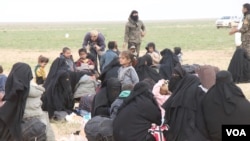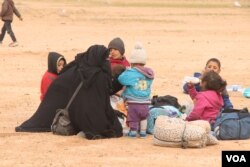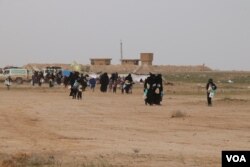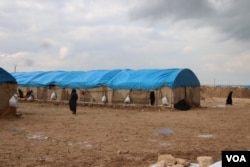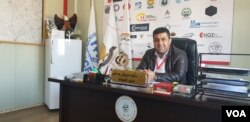It may be almost over for the last enclave of Islamic State fighters in Syria, but the latest humanitarian crisis unfolding in the region is rapidly growing.
On Wednesday, 2,000 more women and children arrived at al-Hol camp in northern Syria after evacuating the battle zone in Baghuz, and many were sick or injured. Aid groups say 12 people died and 60 more were immediately hospitalized, as they prepared for 3,000 more new arrivals.
"These women and children are in the worst condition we have seen since the crisis first began," Wendy Taeuber, International Rescue Committee's Iraq and northeast Syria country director, said in a statement Thursday. "Many have been caught up in the fighting, and dozens have been burned or badly injured by shrapnel."
The death toll among recent Baghuz evacuees is now close to 140, IRC says, with most of the victims being babies or small children.
Aid workers say they "have stopped guessing" how many more people will come out of Baghuz as the crisis grows far beyond all expectations.
Al-Hol camp was originally built to hold 10,000 people, according to the World Health Organization.
The current population stands at more than 72,000 people, mostly women and children related to IS militants. Many of the families retreated with the fighters for months or years as Syrian, Iraqi and coalition forces took back the land IS called their "caliphate."
"We had strict rules," said Umm Ibrahim, as her four children napped by their luggage in the desert near Baghuz, only hours after fleeing the battle in late February. "Women had to wear veils, and men could be beaten if they shaved their beards. But most people didn't have problems."
Ideology lives on
In recent days, internationally backed Syrian forces have closed in on IS fighters, who are now surrounded, on a sliver of land near the Euphrates River.
The ideas and grievances that led to the creation of IS, however, are long from conquered, according to Sheikh Humaydi Daham Al-Hadi, a prominent tribal and provincial leader in northern Syria.
And battles that were characterized by massive airstrikes and the current suffering of women and children in overcrowded camps could draw more sympathy for the group, which has continued to issue threats and stage attacks in Syria almost every day.
"The battle may be ending, but the problem will continue in a different way," he said. "And individual attacks can be even more dangerous than fighting with a comprehensive enemy."
Inside al-Hol camp, some wives and children of IS fighters are quick to vow to rebuild Islamic State. In the meantime, the women say they feel cast aside and accused as the forces that defeated their militants are now in charge of the camps and detention centers where they are all living.
"We were much more comfortable inside Baghuz," said Intesar, a mother of four inside a large muddy tent at the camp in early March. "Even when there was more bombing, we felt safer because no one was watching our every move."
Aid organizations say there is no grand plan to relocate the families to more permanent or comfortable homes. Unchecked, this isolation could be a factor in raising the next generation of extremists in the region, according to Rashid Darwesh Safti, a senior camp manager for the Barzani Charity Foundation in the Kurdistan Region in Iraq.
"The next generation could be harder and more extreme than the last," he said in his office at the Hassan Sham camp in Iraq in late February.
"I recently saw a small child making a doll from the mud," Safti added. "He took a stick and cut off the doll's head and said, ‘God is Great.'"




